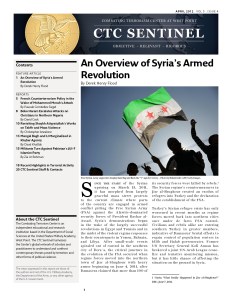Cover Story Overview
An Overview of Syria’s Armed Revolution
By Derek Henry Flood
Since the start of the Syrian uprising on March 15, 2011, it has morphed from largely peaceful mass street protests to the current climate where parts of the country are engaged in armed conflict pitting the Free Syrian Army (FSA) against the Alawite-dominated security forces of President Bashar al-Assad. This article asserts that the FSA is foremost a national liberation movement determined to overthrow the al-Assad regime through a war of attrition. The FSA would prefer a rapid paced revolution, but as the prospect for an external military intervention evaporated over the course of the past year, the rebels have had to be self-reliant while hoping for touted help from individual nation-states. The FSA sees a campaign of protracted warfare coupled with an increase in military defections as its only realistic way forward. The isolation and unanticipated duration of the conflict has led to increased sectarianism in Syria, encouraged regional powers aligned with President Bashar al-Assad to grant him support, and kept the conflict a highly asymmetrical one as the outgunned FSA continues to battle well-armed, pro-regime forces.
 Skip to content
Skip to content

